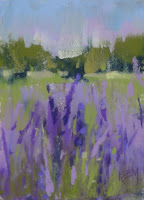 |
| 'A Little Piece of Heaven' 13x18 ©Karen Margulis available $195 |
I have started an Instagram for our camping and painting adventures with Bertie and I'd love for you to follow me. You can find it on Instagram @campingwithbertie
The workshop I taught in Lexington was a 3 day plein air workshop held at the gorgeous farm of one of the artists. There was so much to paint there! The artists in the group were warm and welcoming and very talented. It was a pleasure to share with them. The weather cooperated for the most part. Except there were no interesting clouds after my sky demo and talk! And rain threatened all day on our last day. Because of the forecast I planned to spend the last afternoon inside doing the artist choice demo. For this demo, the artists vote on the photo I will paint. There was a 3 way tie this time and the marsh came out on top in the toss.
Even though it wasn't a plein air demo, the marsh was a good subject to end the workshop with since there was no creeks or ponds on the farm! Here is the demo in it's unfinished state.
 |
| The unfinished demo |
 |
| Demonstrating how to make water a part of the landscape |
Workshop News!
I will be teaching a workshop on November 3 & 4 with Nancy Nowak in Nancy's studio here in the Atlanta area. We will be announcing it this weekend but I wanted to give my readers a heads up. The cost is $250 for this team workshop. Send me an email if you would like more information.
















































